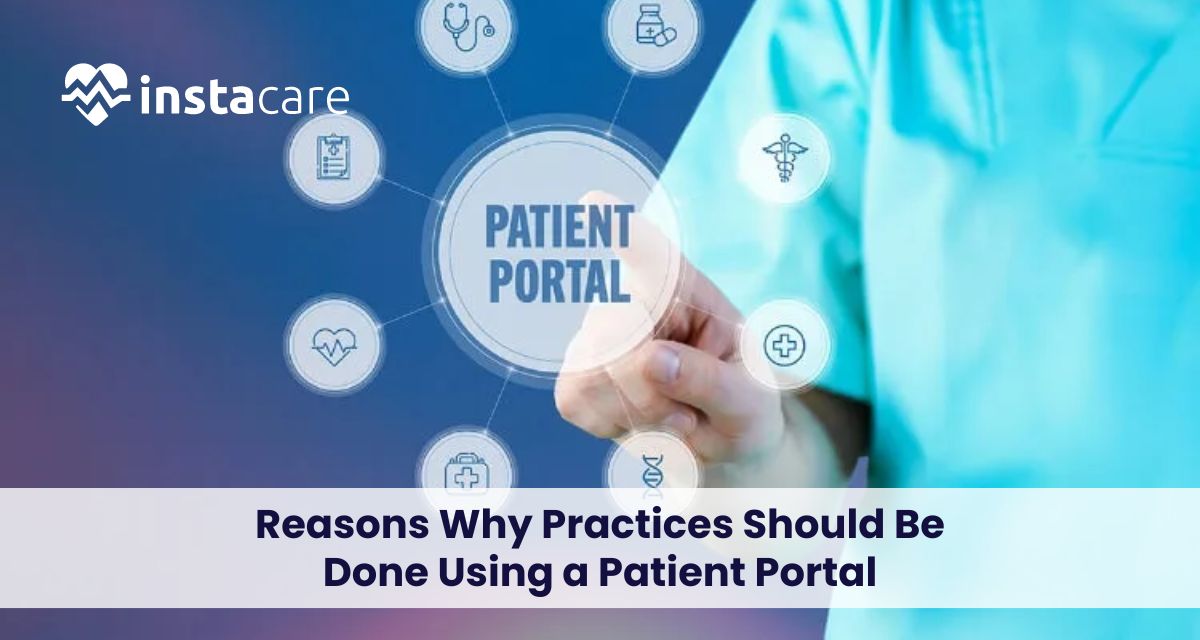Last updated on Friday, 28, June, 2024
Table of Contents
Primary Reasons Why Practices Should Be Done Using a Patient Portal
Under the modern healthcare circumstance, a patient portal has proved to be a rich transformer and can enhance practical functions for medical practices with strategies to engage patients better. A patient portal is a comprehensive web-based platform from which patients are allowed to access a wide scope of healthcare services and information, such as viewing medical records and lab results, and managing future appointments—all from the comfort of one’s home or even on the go, that is why practices should be done using a patient portal.
Here We discuss about some reasons why practices should be done using a patient portal!!
Enhanced Patient Engagement
Patient engagement is very instrumental for better health outcomes and the creation of a proactive wellness culture. A patient portal is a web-based platform that healthcare providers can put in place to allow easy access to health information by their patients, motivating them towards taking an active stance towards addressing their health-related needs. It allows patients to easily view the results of their tests, track their progress over time with graphic trends, and communicate in complete security with their healthcare team—all functionalities that make patients feel more active and informed about their care journey.
Enhanced Communication Efficiency
Effective healthcare delivery is based on effective communication. Patient portals provide one avenue for a patient to communicate with a health provider through features for secure messaging. Besides calling a doctor’s office or physically coming to the office, one can contact his or her doctor for any non-urgent issue, request refill of prescriptions, or clarify the prescription regime. This saves time for both the doctor and the patient and, at the same time, reduces the likelihood of miscommunication or sending messages without passing on the information.
Streamlined Administrative Work
Normally, administrative work devours a hefty resource in healthcare environments. Patient portals put a check to this by essentially automating the routine processes in appointment scheduling, pre-registration form filling, and the processing of billing and payment transactions online. This is, in fact, going to free up staff time, which is usually deployed in the more critical aspects of attending to patients, thus enhancing overall practice efficiency and patient satisfaction.
Enhanced Patient Satisfaction
This goes to the very convenience and quality of health care delivery to them. The greatest contribution that a patient portal can make in relation to the betterment of patient satisfaction is in the easy availability of personal health information and services by the patients themselves that is why recommendation for experts are Practices Should Be Done Using a Patient Portal. An interface designed to be friendly implies that the patients end up in greater control over their interactions in healthcare practices, something that assures highly enhanced patient experiences. They can view their medical records, know the treatment plans, and send a secure message to health providers, which promotes an increase in customer satisfaction and the retention of patients.
Allows Care Coordination
Care coordination is very important in patients with complicated medical conditions or those who receive help from several service providers. Patient portals act as key promoters in sharing between health practitioners. Providers share medical records, test results, treatment plans, and other statutorily required information very securely to continue with the care process without repetition of medical errors. Such collaborative care management promotes overall health outcomes and makes the experiences of the patients more integrated.
Empowers Patient Education
Education is such a strong tool toward accomplishing health literacy and goes further in empowering patients to make appropriate decisions regarding their health. One of the key channels through which a healthcare provider can directly deliver education materials, preventive care guidelines, and an individual’s health information is a patient portal.
Practices Should Be Done Using a Patient Portal, Portals encourage patient education and knowledge regarding diseases, treatment plans, and adherence to a healthier lifestyle. It allows easy access to current and precise information concerning health issues. This proactive approach to patient knowledge makes the health outcomes better and builds the trust-based sound association between patients and health providers.
Facilitates Care Coordination
It’s important that every provider of service in healthcare ensure the privacy of the patients and comply with strict personal data protection legislation—for instance, the Health Insurance Portability and Accountability Act of the United States. Security features prevent unauthorized access and protect sensitive health information in a patient portal.
This technology provides very strong encryption protocols for safeguarding information, secure authentication procedures, and access control from any kind of unauthorized access, manipulation, or divulgence. Ensuring the integrity of the health information and allowing healthcare practice to instill confidence in patients about matter pertaining to confidentiality is a sure way of securing trust from them coupled with ensuring adherence to stipulated regulations.
Supports Remote Healthcare Delivery
In fact, this is really when telehealth services and a global pandemic like COVID-19 have brought out their need the most: for remote delivery of healthcare. Patient portals support virtual consultations, telemedicine appointments, and remote monitoring of a chronic (. These digital platforms offer a chance for patients to access healthcare providers from any point and thus get medical advice at the right time to receive the needed healthcare services without moving physically to reach them. Flexibility in the delivery of healthcare does increase patient convenience, but simultaneously also guarantees continuity during emergencies or disruptions in the traditional healthcare settings.
Conclusion
This allows medical practices to effectively gain in operational efficiencies and patient satisfaction by harvesting the digital platform for communication, administrative streamlining, and empowerment of patients with education and accessibility to health information. This paper concludes by stating that patient portals are certainly an information technology tool category that brings modernity into health delivery and calls for patient-centered care.
Medical practices can effectively benefit in operational efficiencies and patient satisfaction by harvesting the digital platform for communication, administrative streamlining, and patient empowerment with education and access to health information. In summary, as a result of patient portals meeting the changing needs of healthcare consumers, an increased scope is assured for delivering tailored, efficient, and effective health care.
FAQs
1-What is a patient portal, and what are the positive impacts for patients as well as for healthcare providers?
A patient portal is a secure, Internet-based environment that allows patients to log in and access their personally relevant health information, such as medical records, laboratory results, appointment schedules, and even communication with health providers. It provides the patient with easy access to all health data at any time and from any place through the use of the Internet.
2-What is the safety of the patient portals and what may be employed to secure the data?
One would underline that, by now, the very data security has been positioned at the heart of the patient portal that generally comes with the appropriate measures to ensure protection from any access to or use of health information by the unauthorized parties.
3-Other than the viewing of medical records, what else can a patient do with a patient portal?
That’s right. Patient portals go beyond just viewing a copy of a patient’s medical record. Patients can actually schedule face-to-face visits, request refills on prescriptions, fill out pre-visit questionnaires or forms, and pay a bill online. Through some of the other portals, patients and their providers can have direct, secure messaging for clarifying recommendations or education/clarification for a treatment plan in between office visits.
4-How can a patient portal continue supports the provision of telehealth and remote healthcare delivery?
This patient portal allows the patient to attend a virtual consultation with providers, receive telemedicine for non-acute medical pathology, and take part in the remote monitoring of the chronically ill condition.



